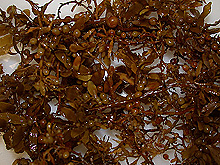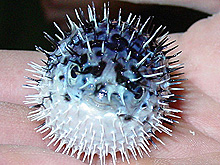
Pelagic brown algae in the genus Sargassum. The berry-like structures are gas-filled bladders known as pneumatocysts, which provide buoyancy to the plant. Click image for larger view.
Sampling the Sargassum Community: Dip Nets and Green-Light Lures
August
25, 2004
H. Scott Meister
Fish Biologist
South Carolina Department of Natural Resources
![]() A
narrated compilation of still photographs. (mp4, 3.7 MB)
A
narrated compilation of still photographs. (mp4, 3.7 MB)
![]() A
giant red shrimp hovers just above the sea floor. (mp4, 3.6 MB)
A
giant red shrimp hovers just above the sea floor. (mp4, 3.6 MB)
![]() A
lizard fish sits on the bottom
and waits for its prey to approach.
(mp4, 1.6 MB)
A
lizard fish sits on the bottom
and waits for its prey to approach.
(mp4, 1.6 MB)
![]() A
small fish hovers near the bottom as a crab hops by.
(mp4, 2 MB)
A
small fish hovers near the bottom as a crab hops by.
(mp4, 2 MB)
![]() A
common sea-floor feature in the study area is an occasional
dune or hill. (mp4, 3.6 MB)
A
common sea-floor feature in the study area is an occasional
dune or hill. (mp4, 3.6 MB)
![]() The Johnson-Sea-Link
II manipulator arm picks up a coral skeleton.
(mp4, 2.8 MB)
The Johnson-Sea-Link
II manipulator arm picks up a coral skeleton.
(mp4, 2.8 MB)
During the Estuary to the Abyss Expedition, we are studying a variety of marine organisms and their habitats in the offshore regions of the South Atlantic Bight. While the majority of these organisms live on or near the ocean floor, one critically important habitat, known as the pelagic Sargassum community, is actually found on the ocean’s surface. After leaving Charleston last evening, where we picked up parts to repair two research submersible support systems, we returned to our study area, about a hundred miles southeast of Charleston. There, we continued to sample Sargassum communities from the sea surface.
The term, Sargassum, refers to the genus of numerous species of brown algae that grow in tropical and temperate areas of the ocean, including the western Atlantic, where we are today. You can think of this algae as a floating plant. Upon close inspection, it is easy to see the many leafy appendages, branches, and round, berry-like structures that make up the organism. These “berries” are actually gas-filled structures, called pneumatocysts, which are filled mostly with oxygen. Pneumatocysts add buoyancy to the plant structure and allow it to float on the surface.
The three tons of Sargassum
Because it resides on the sea surface, Sargassum is at the mercy of both the wind and surface currents, which can push smaller clumps together to form large, dense mats. Groups of mats have covered areas as large as several square kilometers, with a total weight of nearly 2,700 kg (about 3 tons).
The upper meter of the open sea is typically a relatively barren environment in terms of both shelter and food, and this is where the importance of Sargassum becomes evident. The concentrated mats and smaller clumps provide the structure upon which a whole community of diverse living organisms develop and flourish. Beginning with bacteria, a succession of organisms begins to inhabit and colonize the floating algae, setting up an intricate food web. Less complex invertebrates (e.g., hydroids and bryozoans) begin to multiply, providing food for crustaceans (shrimp and crabs), which in turn become prey for a number of juvenile and adult fishes.
The cover and protection offered by Sargassum mats are just as important as food to many of these juvenile fish species. In the absence of this protective habitat, many young fishes would quickly become prey for any number of predatory species (e.g., tuna, barracuda, billfish, jacks, and dolphinfish).

A floating light-trap used to capture larval and juvenile stages of fishes. Click image for larger view.
Sampling these diverse mini-ecosystems requires us to employ a number of sampling methods during this expedition. Our most important tool is a long-handled dip net. Relatively low-tech and inexpensive, these nets resemble a modified version of a butterfly net, only with a much longer handle and larger bag diameter. The net handle is just under 4 m long and made of hollow aluminum to decrease its weight. Sampling with a dip net requires little more than a keen eye, although it helps to have long arms and a strong back.
With the research vessel slowly making headway, we watch for patches of floating Sargassum (the larger the better), and once they are in range of the net, we quickly dip the clumps from the water and drop them in tubs of seawater for sorting. After removing all the fish from the sample, we return the Sargassum to the ocean so it can continue to provide food sources and protection for other organisms.
Night sampling with a light lure
Spotting the floating clumps requires daylight, but we want to sample at night, so we have modified our dip net methods for the dark. Instead of tracking down the fish ourselves, we lure the fish to us. Light in the ocean at night attracts all sorts of creatures, from tiny copepods to swimming crabs and juvenile fishes. Eventually, even adult fishes leave the protective Sargassum to see what’s glowing in an otherwise pitch-black environment. Soon the food chain is in action again with more and more hungry animals arriving by the minute.
Knowing this, we brought what we affectionately refer to as the “Mega Light,” a 5-ft long, iridescent-green, waterproof light powered by a car battery. We hang the Mega over the side, arm ourselves with our nets, and wait for the action. We don't have to wait long before the hungry parade arrives, and soon we're filling our tubs with a multitude of specimens.
As big and bright as the Mega Light is, it has it limits. We can sample only a small area. To increase our sampling area we use another piece of gear, called a floating light trap, to catch small fish during the nighttime hours. Constructed of clear plastic with Styrofoam for flotation, these traps use small glow sticks (chemical lights) to attract and trap small fish.
We place the glowing sticks in the center of the clear trap, tie six traps to a 15 m line, which is attached to the research vessel, and let them drift off the stern. Fish attracted to the lights swim through small holes in the traps, and are then unable to find their way out. After two hours, we pull the line of traps back onto the vessel and sort the catch.
So far these methods have allowed us to catch a variety of fishes, including jacks, filefish, triggerfish, driftfish, and my personal favorite so far, porcupinefish.
We have seen very little Sargassum during this expedition, which has limited our opportunities for capturing specimens, but we still have another week. Just like everything else in the ocean, we are at the mercy of the currents, and so far the currents are transporting most of the Sargassum to places unknown, at least to us. However, the Sargassum community is such a fascinating ecosystem with such a diverse range of organisms, and it plays such a critical role in the oceanic food web, that it is well worth the wait to see what the next clump holds.
Sign up for the Ocean Explorer E-mail Update List.



























